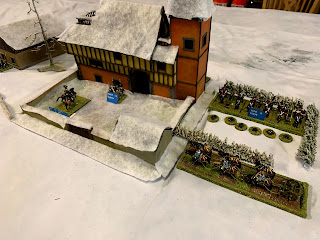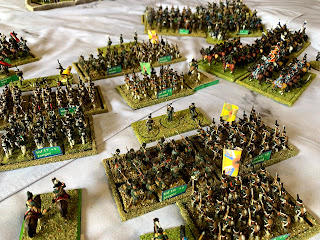La Rothiere 1st Feb 1814.
A great team building event was played out at the weekend. Thank you to all who came and made it happen.
The Terrain.
The massive snow sheets were kindly donated. But it meant that each building needed a covering of snow, as well as the hedges, trees and walls. The covering for each roof was cut out from a roll bought on ebay. The woods and the rest were spray painted. The hills under the mat were also kindly donated even if they were a little difficult to distinguish.
The French had to make certain key decisions as to when to deploy their reserves in order to hang onto the three key villages designated as victory conditions, up against the overwhelming numbers the Allied had at their disposal. They also had to prevent being outflanked. Harsh victory conditions for the Allies but they had overwhelming numbers.
 |
| Doumerc's cavalry and HA (C7) to the north covering the French flank. |
 |
| Valley approach defended by Joubert (Inf 9) in La Giberie. A legere battalion lurks in the woods waiting for the Wurttembergers. |
 |
| Scherbatov's infantry with Lieven's in the distance.(Inf 3 and 4) These two masses of infantry would spearhead the attack on la R. |
 |
| Morvilliers defended by Fournier's naval artillery and legere battalions.( Inf 8) Part of Marmont's Division. |
 |
| Le Forestier Inf 7 (supports Duhesme's units Inf 6) already in La R. Part of Victor's Division. |
 |
| Gerard's men (Dufour Inf 4 and Ricard Inf 5) were to hold the French right flank against the Austrians. |
 |
| Heritier's dragoons (C8) covering the flank with Briche's dragoons (C9) in the distance. |
 |
| Lanksoi's Russian hussars (C2) move to support Scherbatov's advance on La R. |
 |
| L shaped table plan. |
 |
| French Guard cavalry in the centre . (C3,C4,C5) |
 |
| Map showing units and reserves. |
Time was not on the Allies' side so Sacken wasted no time in advancing his Russian infantry immediately towards La Rothiere. Unbeknown to his 21st Century counter part, many of these troops had suffered badly at Brienne days earlier so were not as good in terms of quality as the Russian commander might have hoped for. Indeed Von Lieven had been allocated a -1 for his personal rating. This would not help the assault on La Rothiere. The moment these Russian masses got to within effective artillery range, Drouot's massed battery opened fire. (represented by two foot batteries and one horse battery). To reflect the snow and poor visibility any commander wishing to fire artillery or musketry (not skirmishers) had to throw a 1D8 first. A score of 1 would mean no firing that turn. Frustrating when it did occur.
The Austrians in the south and Wurttembergers in the corner all failed to appear on move two as expected, but did appear by move 3. Wrede's Bavarians and Austrians appeared as planned. (I think)
The French decided to withdraw part of the Guard cavalry (C3) Chabanais Old Guard brigade re-deployed towards Gerard, providing Gerard with some artillery as he had none.
The French reserves:
They also decided to commit Rottembourg's YG brigade (Inf 1) into the defence of Petit Mesnil from move 2. Decouz's YG voltigeurs (Inf 3) were deployed to the flank to help Marmont on move 6. Shortly after Levesque-Laferriere cavalry (C1) was deployed to cover the gap between la Rothiere and Gerard's troops holed up in Dienville. Only Meunier's 1st voltigeurs (Inf 2) and the Honneur Guard (C2) remained in reserve into Day 2. Arguably both should have been thrown in earlier.
 |
| Deployed Bavarian foot artillery. |
 |
| Three smaller brigades of Russian Grenadiers (Inf 16,17,18 appeared on Move 4) advance on Petit Mesnil. |
 |
| French dragoons (C8) move onto the higher ground. |
 |
| Bavarian infantry and Uhlans. |
 |
| The Wurttemberger (Inf 6,7) log jam at La Giberie. Joubert succeeded in holding up this advance for as long as he could. |
 |
| Moves 1-10. |
 |
| French Guard cavalry. |
In an attempt to force Sacken's columns into square, the 10th Hussars (C6, separately brigaded) moved to support Drouot at la Rothiere on the right while some Eclaireur Scout cavalry moved up on the left. Some of Von Lieven's and Scherbatov's battalions were forced into square and were devastated by Drouot's artillery. Despite the supporting brigade of Olsuviev, the Russian advance began to grind to a halt. Successive assaults on the strong point in La R were beaten back. But Victor was going to need some French reserves soon to help his beleaguered force.
 |
| Von Lieven's infantry halted by French artillery. Nikitin's Russian artillery move up to support and re-kindle the stalling Russian advance. |
 |
| French units to the right of La Rothiere. Infantry in square to the rear of the guns |
 |
| Doumerc's cavalry, supporting Morvilliers, face off against the Hussars and Uhlans of the Austrians. |
 |
| Bavarian infantry advance. |
 |
| Hohenlohe-B Inf 2 move up to support Fresnel's Austrian's on the extreme left of the Allied line. Superior artillery here would be crucial to their success. |
 |
| Russian Grenadiers begin their assault on Petit Mesnil, supported by Prussian cavalry (C5) of de Courland. |
By the end of day 1, the French still held La Rothiere, had only lost one building (1/3rd) of Petit Mesnil and still comfortably held Morvilliers. There seemed little threat of the outflanking move, which was also a requirement for an Allied victory.
But all the Allied troops including their Prussian and Russian guard elements had deployed so the storm was yet to come. Russian Dragoons (C3) and Karpov's Cossacks (C4) speared headed the attack into the French void and linked up with the advancing Prince of Wurttemberg. This closed the trap on Joubert whole remaining battalion was forced to surrender.
Decouz's (C3) foot artillery unlimbered to the west of the stream and covered the right flank of Morvilliers. The infantry moved west in at attempt to hold up the Bavarians but were cut down in the process. In hind sight perhaps they could have left one battalion with the guns (which was later over run by Cossacks) and move the remaining two battalions to Morvilliers itself?
Frimont's hard pressed Austrians had kept Marmont occupied around Morvilliers for a long time but were by now a spent force. He was now reliant on the Bavarians to attempt the assault on Morvilliers as time was beginning to run out.
 |
| View of Morvilliers. |
 |
| Wurttembergers, having swept up the valley now prepare to "outflank" the French. |
 |
| French Garde d'Honneur. |
 |
| Horse Grenadiers prepare to attack Russian Cuirassiers. |
 |
| Austrian infantry belonging to Fresnel. |
Russian Guard infantry finally in
 |
| Bavarian foot battery. One round of effective fire remains. |
 |
| Wurttemberg infantry on the march again. |
 |
| Meunier's YG brigade deployed to help defend la Rothiere. This battery covered its left flank. |
 |
| Cossacks (C4) spearheaded a raid deep into the French lines. |
 |
| French foot battery defending the heights of Morvilliers. |
 |
| Moves 1-10 |
 |
| The Wurttemberg foot battery in action. |
 |
| Russian foot artillery pour canister into La Rothiere from the flank. |
 |
| Bavarian hussars. |
 |
| Prussian Guard du Corps. Featured towards the end. |
 |
| Rottembourg watching his YG. The Br R (Brigade rating) was pre-set while the PR (personal rating) could vary from +2 to -1. Each time a brigade lost a unit there was a risk to general. The risk increased for every unit lost. |
 |
| The defence of Petit Mesnil began to crumble despite the late arrival of two regiments of Garde d'honneur. |
 |
| Austrian infantry in the Dienville sector. |
 |
| Bavarians prepare to assault Morvilliers. |
 |
| The Austrian foot battery covering the assault on Dienville. |
 |
| Russian horse battery firing across the rear of La Rothiere. French YG supporting infantry were swept away. |
 |
| Bavarian infantry veer towards Morvilliers. |
 |
| Morvilliers which the French held until the final throw of the dice on the last move. |
 |
| 2nd day's movement. |
 |
| The final positions |
 |
| Pavlov Grenadiers finally take the credit for taking la Rothiere. |
Littleffort was made by French forces to take back Petit Mesnil as the Prussian Guard infantry were closing in fast, which made such an attempt impossible. However, Meunier's YG did try to throw back the Pavlov Grenadiers who had just taken the strongpoint and 2nd building comprising La Rothiere. Neither attempt was successful and their crucial supporting infantry were blown away by Russian artillery before another assault could be made.
 |
| 2nd battalion of Pavlov G march past La Rothiere and look set to sweep away the few remaining French skirmishers. |
 |
| Allied losses. 33 bns of Infantry (mainly Russian) 15 Regts of cavalry and 9 skirmish stands. No artillery lost. |
 |
| French losses. 30 bns of infantry. 16 regts of cavalry. 12 skirmish stands. 4 foot batteries and 4 HA batteries. Various colours lost including the eagle belonging to Joubert's force in La Giberie. |






No comments:
Post a Comment